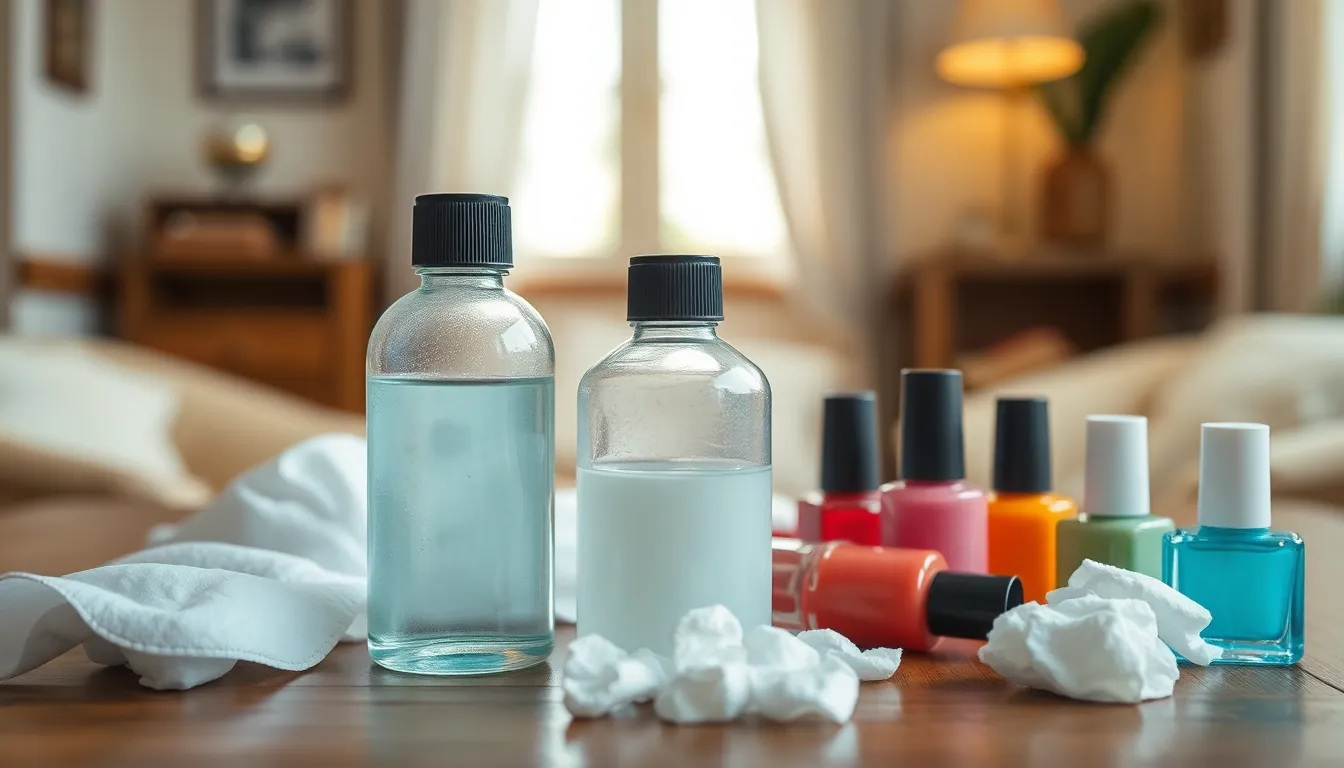Table of Contents
ToggleEver wondered what’s lurking in that little bottle of nail polish remover? It’s not just a magical potion that makes your nails go from fabulous to fresh in seconds. It’s a concoction of chemicals that can make even the most daring chemist raise an eyebrow.
Overview of Nail Polish Remover
Nail polish remover primarily contains solvents that dissolve nail polish. Acetone ranks as the most common solvent in these products, known for its effectiveness and quick action. Isopropyl alcohol serves as an alternative, often found in non-acetone removers that are gentler on nails.
Ethyl acetate also appears in many formulations. This ingredient provides similar dissolving properties to acetone without the strong odor. For a milder option, formulations might include propylene carbonate, which is less harsh on skin and nails.
Additional ingredients enhance the remover’s performance. Moisturizers, such as glycerin or aloe vera, may help counteract drying effects. Fragrances often mask strong chemical scents, improving overall user experience.
Nail polish removers can vary significantly in composition. Many brands focus on creating products that appeal to specific consumer needs, such as removal ease or skin sensitivity. Always check ingredient labels to identify particular components and select a remover that fits personal preferences and nail care requirements.
Consumers should note the impact of each ingredient. While acetone and ethyl acetate work quickly, they can be drying. Non-acetone removers typically take longer to remove polish but are gentler, making them suitable for weaker or damaged nails. Understanding these differences aids in making informed choices about nail care products.
Common Ingredients in Nail Polish Remover

Nail polish removers commonly contain solvents and additional ingredients to enhance performance and user experience. Understanding these components helps consumers make informed choices for nail care.
Acetone
Acetone serves as the primary solvent in many nail polish removers. Known for its rapid action, it dissolves polish quickly, making removal efficient. Some users appreciate its effectiveness, especially for stubborn formulas. However, its strong odor can be off-putting and may cause dryness in some individuals. Acetone’s potency leads to quicker removal but can strip natural oils from nails and skin. Many opt for acetone removers for fast results, but considerations for sensitivity are essential.
Non-Acetone Solvents
Non-acetone solvents, like isopropyl alcohol and ethyl acetate, provide alternatives for those seeking gentler options. These solvents often produce fewer odors and are less likely to cause skin irritation. Isopropyl alcohol effectively removes polish but can be slower. Ethyl acetate mimics the effectiveness of acetone while offering a milder scent. For those prioritizing a less harsh experience, products containing propylene carbonate or glycerin help reduce drying effects. Non-acetone removers appeal to users looking for a balance between performance and gentleness.
Additional Components
Nail polish removers contain various additional components that enhance their effectiveness and user experience. Understanding these ingredients aids in selecting the right product.
Fragrances
Fragrances often play a crucial role in nail polish removers. These additives help mask the strong chemical odors associated with solvents like acetone. Many consumers prefer products with pleasant scents, making the removal process more enjoyable. Citrus and floral fragrances are common choices. They not only improve user experience but also create a perception of freshness. Focus on products labeled with “additionally scented” to ensure a more favorable aroma during use.
Conditioning Agents
Conditioning agents help mitigate the drying effects of solvents. Glycerin and aloe vera frequently appear in formulations. These ingredients add moisture back to the nails and cuticles. Some brands prioritize including nourishing oils, such as vitamin E, for added benefits. Users may notice a significant difference in nail health when choosing removers with conditioning agents. Seek products that highlight these ingredients for a gentler and more protective experience during polish removal.
Safety and Health Considerations
Nail polish removers contain solvents that can pose safety and health risks. Acetone, while effective, has been linked to skin irritation and dryness. Exposure to acetone may lead to headaches or dizziness, especially in poorly ventilated areas. Using these products in well-ventilated spaces minimizes risks.
Isopropyl alcohol carries similar concerns but at a slightly reduced intensity. Though it can cause irritation, it is generally considered safer than acetone. Ethyl acetate may also cause skin reactions, particularly for those with sensitivities.
Handling nail polish remover with care is essential. Wearing gloves can provide a barrier to protect skin during application. Keeping removers away from heat sources and open flames is critical as they can be flammable.
Many brands incorporate moisturizers like glycerin and aloe vera to alleviate some drying effects. Ingredients such as these are beneficial for maintaining skin hydration and nail health. Checking product labels helps consumers identify formulations that align with their health concerns.
Fragranced removers, while enhancing the experience, can contain allergens. Those with allergies should opt for unscented or hypoallergenic products to avoid adverse reactions. Seeking products with safer ingredient profiles allows individuals to enjoy nail care while safeguarding their health.
Understanding what’s in nail polish remover can empower consumers to make informed choices. With a variety of solvents and added ingredients available there’s a remover for every preference and need. Whether opting for acetone for its speed or a gentler alternative like propylene carbonate, it’s crucial to consider both effectiveness and skin health.
The addition of moisturizers and fragrances can significantly enhance the user experience while reducing potential irritation. By paying attention to ingredient labels and selecting products that align with personal sensitivities, individuals can enjoy effective nail care without compromising their well-being. Making educated decisions about nail polish remover ensures a balance between beauty and health.




